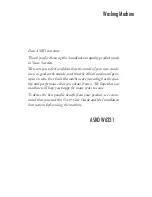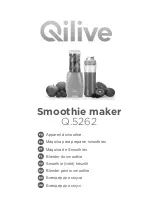
Food Dehydrator
SFD 851GR
EN
EN-9
Copyright © 2016, Fast ČR, a.s.
Revision 05/2016
PRePARAtIon
The enzymes contained in fruit and vegetables affect the colour and change in flavour during the
ripening process. These changes will continue even during dehydration and storage unless the product
is prepared in such a way as to slow down enzyme activity.
When preparing vegetables, they may be pre-cooked – this helps to retain colour and accelerates the
dehydrating process by loosening their fibres, whilst preventing undesirable changes in flavour during
storage and improves the vegetable reconstitution process during cooking.
Many light-coloured types of fruit (especially apples, apricots, peaches, nectarines and pears) are
prone to darkening during dehydration and storage. To eliminate this issue, the fruit should be prepared
by pre-cooking or soaking in appropriate solutions – the effectiveness of these methods varies.
Here are several tips for preparing solutions:
•
Pineapple or lemon juice serves to reduce browning. Slice the fruit directly into the juice. Take it
out after 2 minutes and place it on the drying trays. To achieve a pleasant aroma, you may also soak
the fruit in honey, spices, lemon or orange juice or sprinkle with coconut. Use your imagination and
prepare your very own aromatic solution.
•
Sodium bisulphite (sodium hydrogen sulphite): dissolve 1 teaspoon of sodium bisulphite in 1.13 l of
water. Soak the prepared fruit in this solution for 2 minutes. This will prevent loss of vitamin C and
help retain a radiant colour. Sodium bisulfite can be purchased at pharmacies.
•
Table salt solution
•
Ascorbic acid solution or citric acid solution. Also, a commonly sold antioxidant powder containing
ascorbic acid may be used, but it is often not as effective as pure ascorbic acid.
Fruit may be pre-cooked in steam, however this may soften it and make further processing more
difficult.
Pre-cooking with syrup helps retain the colour of apples, apricot, figs, nectarines, peaches, pears and
plums. The final result will be sweeter.
It is good to pre-cook fruits with a tough peels (grapes, dried plums, plums, cherries, figs and certain
berries) in water to lightly rupture their peels. This enables moisture to come to the surface faster
during dehydration.
Before the actual dehydration process, remove excess moisture from the surface of the food by placing
it on clean paper towels. The drying trays should be covered with a layer of food of the recommended
thickness (see tables). If necessary, spread a fine cloth (fine gauze) on the drying trays to prevent the
individual food pieces from sticking.
The amount of food per dehydration batch, should not exceed 3/4 of the surface area of each tray and
slices should not be thicker than 0.6 cm.
ReConstItUtInG FooD to Its InItIAl stAte
Not all dehydrated food must necessarily be reconstituted to its initial state. Especially fruit is better in
the dehydrated state. On the other hand, most types of vegetables are tastier when reconstituted to
their initial state.
To reconstitute vegetables for cooking, simply wash them in clean water and then place them in cold,
unsalted water and cover. If possible, allow them to soak for approximately 2 – 8 hours, then cook them
in the water that you used for soaking. If necessary, add more water. Bring to a boil, then reduce the
temperature and gently cook until ready. At the end of the cooking process, you may also add salt,
which will slow down the reconstitution process. As far as fresh products are concerned, overcooking
them will reduce their aroma. To reconstitute vegetables, e.g. carrot, use cold water for soaking.




































